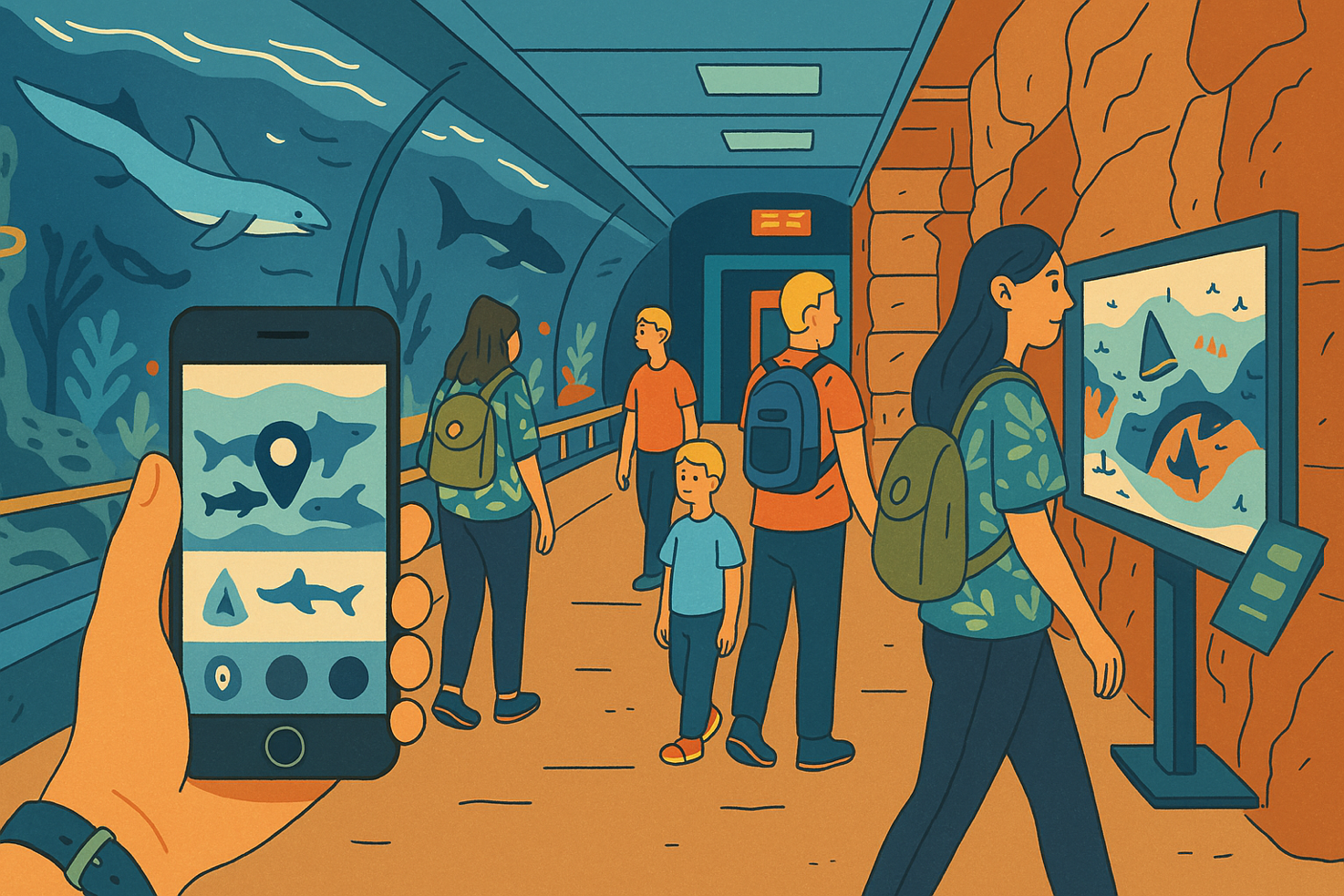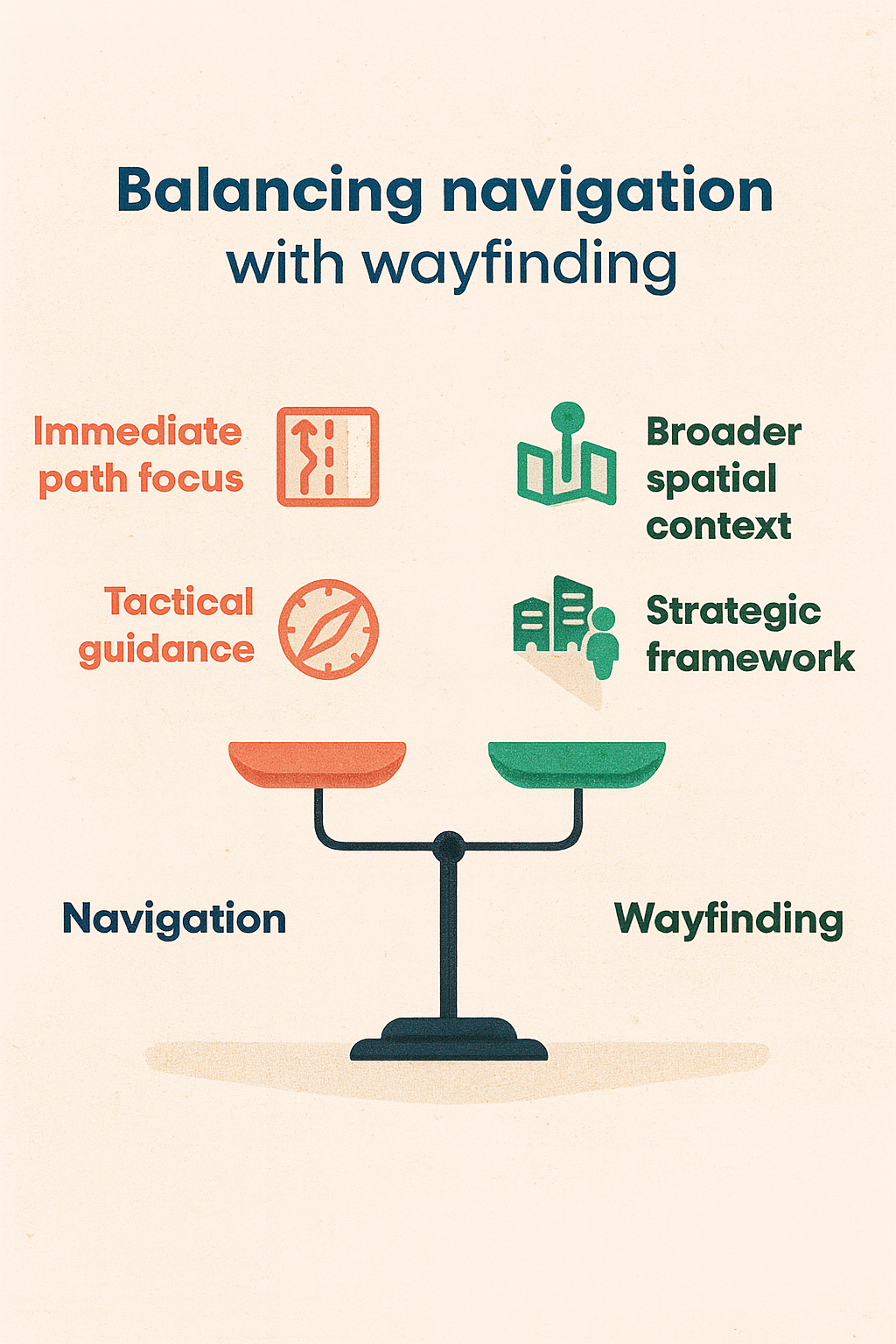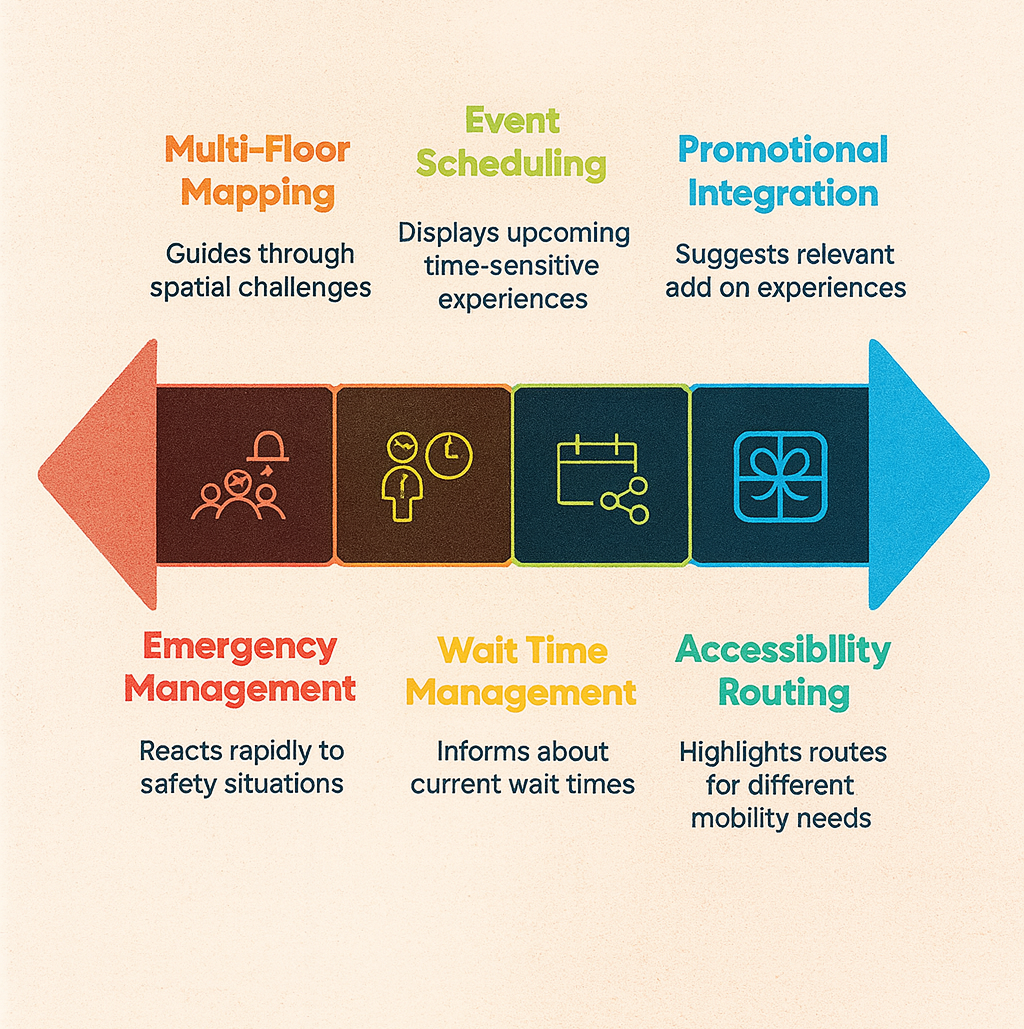The Nutmeg guide to smart wayfinding

What is digital wayfinding and how is it different from navigation?
Intelligent guidance like this is just one example of modern digital wayfinding. By combining location awareness technology with real-time data and personalized recommendations, wayfinding through smart maps can transform what was once a navigation challenge into an engaging discovery tool.
Navigation vs. wayfinding: What's the difference?
The distinction between navigation and wayfinding is important when implementing digital guest solutions. While these terms are often used interchangeably, they represent different aspects of the guest experience.
Navigation refers to the specific, step-by-step directions that guide guests from point A to point B. Think of navigation as the tactical component: “turn left at the gift shop, proceed straight for 100 feet, and arrive at the dolphin exhibit.” Navigation is directive and focused on the immediate path ahead.
Wayfinding, however, encompasses the broader system that helps guests orient themselves within a space and understand their options. Wayfinding includes environmental design, spatial awareness, landmark recognition, and the overall guest's ability to form a mental map of the venue. It's the strategic framework that makes navigation possible and meaningful.
In digital applications, navigation might provide turn-by-turn directions to the nearest restroom, while wayfinding helps guests understand where they are in relation to major attractions, how different areas connect, and what experiences are available nearby. Effective digital wayfinding systems excel at both: they orient guests within the larger context while providing precise navigation when needed.
For venue operators, this distinction matters because guests need both capabilities. For operators, this means striking a balance between the two in order to increase engagement. A guest entering your site needs wayfinding to understand the layout and possibilities, then navigation to reach specific destinations efficiently. Digital platforms that excel in wayfinding create confident, engaged guests who explore more areas and have higher satisfaction levels.

Traditional signage is like using a Rand McNally atlas in a Google Maps world—technically accurate, but never updated.
Benefits of digital wayfinding vs. traditional wayfinding
Digital wayfinding delivers measurable advantages over traditional static signage, benefiting both guests and venue operators. These improvements address fundamental challenges that attractions face in managing guest flow and satisfaction.
- Real-time adaptability gives digital systems a crucial edge over static alternatives. When an attraction suddenly closes for maintenance, or a surprise event kicks off across the venue, digital maps instantly update to suggest alternatives, while traditional signage is like using a Rand McNally atlas in a Google Maps world—technically accurate, but never updated.
- Personalized experiences become possible through digital platforms. A family with young children receives different recommendations than thrill-seekers, while guests with mobility considerations can get accessible route options. This level of personalization transforms how different guest segments experience your venue.
- Multilingual support means international guests get the same seamless experience as locals, without managing dozens of translated signs. Smart maps switch languages instantly—whether your guests speak English, Spanish, or Mandarin, they'll navigate with confidence.
- Data collection and operational insights provide attraction managers with unprecedented visibility into guest behavior. Digital wayfinding systems track movement patterns, popular destinations, and dwell times, enabling data-driven decisions about staffing, attraction placement, and guest flow optimization.
- Reduced staff burden occurs when guests can independently find information and directions through digital platforms. Staff can focus on high-value guest interactions rather than providing basic directional assistance. This efficiency improvement directly impacts operational costs while enhancing overall guest service quality.
- Enhanced accessibility features include adjustable text sizes, high-contrast modes, and audio guidance options that serve guests with diverse needs. Digital platforms can accommodate accessibility requirements that would be costly or impossible to implement with traditional signage alone.
Common uses of digital wayfinding
Digital wayfinding applications extend far beyond basic navigation, creating opportunities to enhance every aspect of the guest experience while supporting operational efficiency. These capabilities exist on a spectrum from reactive solutions that respond to immediate needs—like multi-floor mapping and emergency management—to proactive features that anticipate guest interests through promotional integration and accessibility routing.
- Multi-floor mapping addresses one of the most common navigation challenges in complex venues. Aquariums, museums, and entertainment centers often span multiple levels, creating confusion for guests trying to understand spatial relationships. Digital wayfinding provides clear floor-by-floor guidance with seamless transitions between levels, helping guests visualize their complete journey.
- Wait time management integration allows guests to make informed decisions about their time. Rather than discovering long lines upon arrival, guests can view current wait times and plan their route accordingly. This transparency reduces frustration while helping distribute crowds more evenly across attractions.
- Event and show scheduling keeps guests informed about time-sensitive experiences. Digital wayfinding platforms can display upcoming feeding times, performances, or educational presentations, complete with navigation to those locations. This proactive information sharing increases attendance at scheduled events while reducing missed opportunities.
- Accessibility routing ensures all guests can navigate effectively. Digital systems can highlight wheelchair-accessible paths, identify elevators and ramps, and provide alternative routes that accommodate different mobility needs. This inclusive approach improves experiences for guests with disabilities while demonstrating your venue's commitment to accessibility.
- Emergency management capabilities allow rapid communication during safety situations. Digital wayfinding systems can instantly display evacuation routes, emergency assembly areas, or weather-related shelter locations. This real-time communication capability enhances guest safety while supporting staff emergency response procedures.
- Promotional integration creates natural opportunities to highlight special offers, seasonal events, or underutilized attractions. As guests navigate toward their chosen destination, the system can suggest relevant add-on experiences or dining options along their route. This contextual promotion approach feels helpful rather than intrusive.

Digital wayfinding trends
The landscape for digital wayfinding continues to evolve rapidly, driven by advancing technology and changing guest expectations. Several emerging trends are reshaping how guests discover points of interest:
- AI-powered personalization is the next frontier in digital wayfinding. Machine learning algorithms analyze guest behavior patterns to provide increasingly sophisticated recommendations. Rather than generic suggestions, AI can harness real time data. For example, it could identify that families with young children typically enjoy specific attraction sequences or that repeat visitors prefer discovering new areas they haven't explored.
- Voice-activated guidance accommodates guests who prefer hands-free interaction. Voice commands allow easy navigation–imagine a mother with her hands literally full with belongings, food, or children. This technology also greatly benefits accessibility, enabling guests with visual impairments to interact naturally with wayfinding systems.
- Augmented reality integration overlays digital information onto the physical environment through smartphone cameras. Guests can point their device at attractions to receive instant information, view wait times, or access multimedia content. AR wayfinding creates immersive experiences that blend digital guidance with real-world exploration.
- Predictive crowd management uses historical data and real-time inputs to forecast congestion patterns. Advanced systems can recommend optimal visit timing, suggest alternative routes during peak periods, or proactively direct guests to less crowded areas. This predictive capability helps attractions manage capacity while improving guest satisfaction.
- Cross-platform integration connects wayfinding with other guest services like mobile ordering, ticket purchasing, and feedback collection. Rather than switching between multiple apps or systems, guests access comprehensive services through unified digital platforms. This integration reduces friction while providing attractions with complete guest journey visibility.
Transform your guest experience with Nutmeg's smart mapping platform
Digital wayfinding represents more than technological advancement—it's a strategic opportunity to differentiate your site while improving operational efficiency. Nutmeg's smart map solutions combine intuitive wayfinding with powerful guest engagement features, creating seamless experiences that drive satisfaction and revenue.
Our platform delivers real-time indoor and outdoor mapping, interactive navigation, and AI-powered guest assistance that transforms how visitors explore your venue. From multi-floor attractions to complex outdoor spaces, Nutmeg provides the wayfinding intelligence that modern guests expect.
Ready to discover how smart mapping can enhance your guest experience? Contact our team to explore tailored solutions for your venue.
Turn one-time visits into lasting connections






